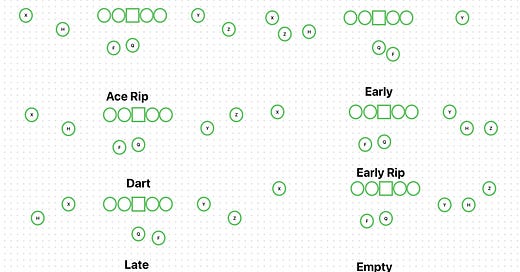We published a summary of the e-book here. I encourage you to either download the e-book, which is free for MGN subscribers, or simply buy it outright for the 3.99 or so that it costs you. You could even check it out at a library — like Overdrive or something.
I promised some more depth on the matter of the offense and defense. The e-book format is not great for diagrams and audio/visual links. I tried to keep it high-level, yet informative. Here we will go into deeper detail about the offense.
In major college football, the last true Air Raid purveyor was Mike Leach. It makes sense, as he was a unique personality and singularly responsible for trailblazing the Air Raid — I believe he coined the name. He famously was the OC and public relations guy at Valdosta and would let the press know how many yards they threw for.
Football has a lot of characters and true believers and it is also a very practical game. The good ideas are stolen, incorporated into the body of knowledge, and used to win football games. There are hundreds of guys looking for any edge, and there are over 100 yards of football ideas and situations from which to mine. The Air Raid was gathered from West Coast ideas, BYU’s offense, Baltimore Colt’s WR Raymond Berry, and circumstance.
Lincoln Riley, Sonny Dykes, Seth Littrell, Dana Holgersen, and Eric Morris among many others have all adapted their systems into a version of the offense they run today. As the ‘Raid went from a system run by disadvantaged rosters to one by power conference squads with 5-star talent we have seen it develop and grow.
The “system QBs” are now first-round draft picks. So it goes.
Eric Morris runs many of the same concepts he learned from being a player. He has expanded the run game using a lot more gap runs. WSU and MSST under Leach used mostly inside and outside zones with some DART (backside tackle pulls and leads) to change things up.
NT has had an air-raid coach (Harrell/Littrell) who ran a lot. We also have looked at what NT’s run game (under Littrell) looked like when it was not working as well. We have also looked back at some run game stuff in various preview posts.
Air Raid 101
The Air Raid is a philosophy more than a set of plays or a system. Leach, Mumme, et al all have different flavors and favorites. Originally it was run out of two and three wide sets, with two backs. Eventually Leach added “standard” 4-wide sets. Now you see much more TE and empty looks. The overriding philosophies are spreading the defense, and finding grass with your athletes. Take what the defense gives you, but also makes sure the defense is defending the entire length and breadth of the field. Beyond that it is about getting great at what you do. The playbook has been changed as coaches have decided to focus on other things they want to get better at. There is only so much practice time so you want to spend it efficiently. Holgorsen got rid of 92 — Mesh — at West Virginia because he thought it was too expensive!
Eric Morris spent time as Kliff Kingsbury’s offensive coordinator, where they used more empty sets and some NFL pass concepts (Levels). We have seen the classic Air Raid calls, but also some more (relatively) unique looks from the Briles offensive tree (the stacked doubles look).
The staple passing plays — or should I say “characteristic” passing plays are Mesh (92), Y-Cross (95), Y-Sail (94), Y-Stick (618), Shallow (91), and Y-Corner (8). Of course there is 4-Verticals (6). The 1999 playbook had an 80-series that was just the 90-series with play-action. I don’t know what they call the RPO game on Morris’ sideline. The idea is the same, however. You choose some concepts, package them, give them a name instead of calling out each individual route, and practice them until you cannot get them wrong. The freedom given to the QB is about calling plays, but also about changing a particular route. Maybe the call is Ace 98 (doubles and a smash concept to both sides) and you decide that corner is going to bite hard on the quick hitch. The QB gives the call that Ace 98 is now Ace 98 X-Sluggo and that X runs a sluggo and is wide open through the middle. Fun!
Against Cal, after running Mesh from Ace1 and then a quick gap-run from Early, followed by a deep post from stacked Ace2 all in less than one minute. This is nothing new for spread offenses but packaging the names of the formation, playcall+tag is how you get these called quickly and keep it moving with maximum efficiency.
Everything below this paywall is gif-heavy so maybe click ‘open in app’ or ‘read in browser’ or what-have-you.
Keep reading with a 7-day free trial
Subscribe to Mean Green Nation to keep reading this post and get 7 days of free access to the full post archives.







